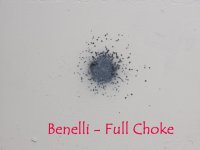Density? not certain what you mean.
Chokes come down to us from the ages, from the days of lead shot, card/fiber wads, paper hulls and no plastic shot cups.
A certain choke was whatever constiction it took to achieve a certain percentage of pellets in a 30inch circle at 40 yds. I don't recall the numbers, except for 12ga, full choke meant 70% in the circle.
My Grandfather's rule for checking a full choke gun (in the shop) was to see if a dime would balance in the muzzle. Full choke 12ga, made before modern ammo, it will. New made gun today, the dime will fall through.
While you get results from the pattern board, when comparing different gauges, they are slightly misleading. This is because the board catches all the shot, and not just the fraction of the pattern that a bird enounters when it intersects the shot string.
While you can shoot the same weight of shot in 12 & 20, the amount of pellets on the plane of the bird (at the instant of impact) is less, due to the smaller gun's longer shot string.





